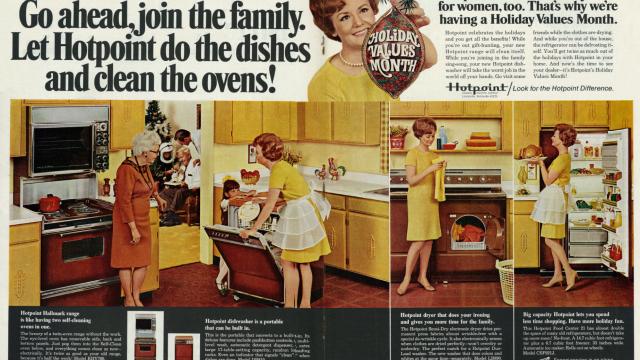A belated New York Times obituary pays tribute to inventor Frances Gabe, who designed, built, and lived in “the world’s only self-cleaning home.” Gabe comes across as a delightful and ingenious crank in a home full of “Honey I Shrunk the Kids” contraptions. Her big idea: Turn the average home into a giant dishwasher.
Illustration via Classic Film
Gabe used her house as the prototype for a technology she hoped to spread across the country. It was a messy execution, hacked together with existing materials and a cement mixer in the yard, with ceiling sprinklers that rained down on waterproofed rooms. The floors were slightly sloped and coated in varnish, the bed covered in a canopy, the books protected by “waterproof jackets.” And the pipes would burst, spraying water in unwanted directions, as caught on video by the local news:
But this is the nature of prototypes. They haven’t been run through the design department; no one has picked a consumer-friendly colour; they don’t come with accessories to fill in the gaps.
Cleaning is not easy. It means putting dirt, or “matter out of place,” back where it belongs. Fundamentally, it’s a fight against entropy, a losing battle that creates its own temporary mess with soap and water and bags full of garbage. This most difficult work is assigned overwhelmingly to women, then devalued as a subservient role. The 3 million Americans working as janitors and maids make well under $US30,000 ($37,707) on average; millions of stay-at-home spouses work for whatever their partners grant them; and millions more take on cleaning as a thankless “second shift” in their off-hours from full-time jobs.
While housework technology has made massive strides over the past century, it remains highly un-automated. The existing innovations involve trade-offs. The washing machine and dishwasher are less precise and more aggressive than hand-washing. The Swiffer requires refills and creates trash. The Roomba has trouble with complex floor-carpet topography. We make allowances for these machines; we buy dishwasher-safe glassware and easy-to-wipe countertops. All Gabe asked for were a few more of these allowances, in exchange for a life free of scouring and scrubbing and stooping.
In certain cases, this is an excellent trade-off. Ovens bake their own grime off; Teflon-treated clothes and cookware wick away unwanted grime. Cities like Paris, Boston, and San Francisco maintain self-cleaning public toilets, which hose themselves down much like Gabe’s kitchen. An example from Dresden:
A self-cleaning public bathroom is Gabe’s vision brought to life where it matters most. The demo video above looks a lot like the following tongue-in-cheek simulation of Gabe’s house, made by artist Lily Benson after a visit to the real thing.
In this low-fi CGI treatment, comically unrealistic blobs of water pour chaotically over the kitchen furniture. It makes the downsides obvious, but it also shows just how much Gabe’s vision resembles other grand concepts like space elevators or Elon Musk’s Hyperloop. Every big idea looks ridiculous in its early stages.
In the case of Gabe’s house, even the basic concepts can seem ludicrous. It asks you to entirely rethink your priorities. Would you fill your house only with waterproof items, just to avoid mopping and dusting? Would you constantly drench all your dishes in water to avoid unloading the dishwasher?
These don’t seem so extreme when compared to the compromises we already agree to: Would you buy lettuce in a bag so you didn’t have to wash it? Would you maintain a database of your friends so you could keep in touch? Would you cover the earth in pavement to move around it faster? Would you spend your life staring into lights, to make more time for staring into more lights?
Ultimately, the public wasn’t ready to make Gabe’s proposed tradeoffs, but like the nuclear car, the supersonic airliner, and the modular phone, they were still important to consider. The self-cleaning house doesn’t exist as a template for the home of the future. It exists to teach us a lesson: There’s always room to increase efficiency, if you’re ready to lower your standards.

Comments